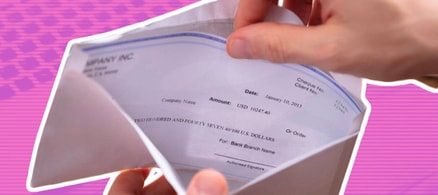File for an extension
The most obvious answer is to file for an extension. By filing IRS Form 4868, you get an automatic six-month extension of time to file. That moves the filing date out from April 18 to October 16.
But what if, for whatever reason, you fail to file an extension request by April 18 or get the extension and still don't file your taxes by October 16?
A lot of things start to happen, and none of them are good. But before we get into the consequences of not filing your taxes on time, let's first take a look at what you can do to minimize the damage.
File your tax return as soon as possible
If you fail to file your taxes by the deadline, whether that's April 18 or October 16, you should still file as soon as possible.
If you fail to file, it will be only a matter of time before you hear from the IRS. Nearly every employer and financial institution that pays taxable income to you issue you either a W-2 or 1099.
But they are also required to send a copy to the IRS. If the IRS receives either document and it doesn't match an income tax return from you, it sends you a letter.
Now, it may be possible to receive either a W-2 or 1099 (or even several) and still not be required to file a return. This is usually because even with the income received, you're still below the income filing threshold.
If that's the case, respond to the IRS letter by letting them know you are below the threshold for filing. That should clear up the problem.
But if you are required to file and don't, filing as soon as possible minimizes the cost in penalties and fees. How much those penalties and fees depend on how much you owe.
An extension to file is not an extension for payment
You should know that even with an extension, penalties and interest apply if your full tax liability isn't paid by April 18. The IRS requires full payment of your tax liability with your filing for an extension.
If you fail to file by the extension deadline and don't have a tax liability — or if you're entitled to a refund — no penalties or interest apply. But the situation changes if you owe tax and didn't file for an extension.
Penalties
The IRS assesses a late-filing penalty of 5% per month on the unpaid tax liability for up to five months. That's a total of up to 25%. For example, if your unpaid tax liabilities are $3,000 and you don't file a return for three months, the IRS adds $450 to your liability. And if you file five months late or later, the IRS adds $750 to your liability.
- Filing an extension by Tax Day avoids the late-filing penalty.
- But if have a tax liability and fail to file by the tax or extension deadline, that's when things start to get uncomfortable.
- First, the 5% per month late filing penalty applies to the unpaid tax liability.
- Then there's a late payment penalty added on top of that. That's assessed at a rate of 0.5% per month (6% per year) until the taxes are fully paid. This penalty also tops out at 25%, which means it will be applied for “only” 50 months.
Interest
And then there's interest on the unpaid balance. The IRS's current interest rate assessed on unpaid taxes is presently 7% (the rate can change quarterly). Interest applies to the unpaid balance of both your tax liability and applicable penalties until the combined balance is fully paid.
It's also important to realize there is no statute of limitations on penalties and interest. The IRS can apply either or both to any tax returns that haven't been filed — or tax liabilities that remain unpaid — for as many years back as it chooses.
If an unpaid tax liability is outstanding for many years or if liabilities for several years remain unpaid, it's possible for the combination of penalties and interest to exceed the original tax liability.
This is why it's important to file your returns and pay your taxes as soon as possible.
How to pay your tax liability to the IRS
The easiest way is to file your tax return and pay the corresponding liability with the return. If you paper file your return, include a check made payable to the United States Treasury for the amount owed. If you file electronically, send your payment electronically using IRS Direct Pay. There's no cost for this payment method if you pay from your bank account.
If you can't afford to pay the full amount at the time you file your income tax return(s), you should send as much as you can when you file. However, the IRS does give you payment options if you can't make the full payment.
Short-term payment plans
The IRS gives you up to 180 days to pay your tax liability, though if you're filing online the time limit is just 120 days. You need to complete an Online Payment Agreement (OPA) online or call the IRS at 800-829-1040.
There is no fee to set up this payment arrangement. But interest and penalties apply as described above.
Installment agreement
If you can't pay your full tax liability within the limit under the short-term payment plan, you can apply for an installment agreement. The IRS gives you up to 72 months to pay under this agreement.
To apply, complete an OPA plus an IRS Form 9465, Installment Agreement Request.
If the agreement is approved, the IRS provides several payment options:
If the agreement is approved, the IRS provides several payment options:
- direct debit from your bank account
- payroll deduction from your employer
- credit card, check, or money order
- cash at a retail partner
- the Electronic Federal Tax Payment System (EFTPS)
The IRS does charge a fee to set up an installment agreement. It's a one-time fee of $31 if the plan is set up by direct debit, or $130 for non-direct debit agreements ($43 for low-income agreements).
And just as with short-term payment plans, penalties and interest apply. In fact, they'll be imposed on the unpaid balance until it is fully paid. It's in your best interest to pay off your installment agreement as soon as possible to avoid a large accumulation of these additional fees.
Offer in compromise
This is an option you may want to pursue if payment of the entire liability is impossible, both now and in the future. An offer in compromise essentially enables you to settle your tax debt for less than the full amount owed. You can apply for the offer if paying the full liability would result in financial hardship.
In considering whether or not to grant the offer in compromise, the IRS considers your ability to pay, income, expenses, and asset equity.
To qualify, you must have filed all required tax returns and made any required estimated tax payments. You're not eligible if you are in an open bankruptcy proceeding.
You need to submit with your application a payment equal to at least 20% of the total amount you're proposing to pay. However, the initial payment is not required if you meet low-income certification guidelines. Those guidelines are spelled out in Form 656, Offer in Compromise application.
The remaining balance must be paid in not more than five periodic payments.
There is a fee of $205 unless you qualify for the low-income certification or submit a Doubt as to a Liability offer.
The consequences of not filing or paying
The IRS provides plenty of options to allow you to file and pay your tax liability afterward. But if you fail to take advantage of those options, the situation gets progressively worse.
- First, if you owe tax and fail to file your tax return, this falls under income tax fraud. That's a criminal charge that can even result in jail time.
- But there's also the possibility the IRS could make a determination of your tax liability from records filed with the agency or as a result of a tax audit for the years in question.
- If it gets to that point, you won't get to claim any legitimate tax deductions on your returns. The net result could be a higher tax liability than would've been the case had you filed the required returns. This is another reason it's important to file your return even if you can't afford to pay.
- If you fail to pay your tax liability voluntarily, the IRS can obtain a tax lien against your assets, enabling them to seize those assets. It can even obtain a levy to garnish your wages until the debt is fully paid.
- You should also be aware the IRS is now making use of collection agencies to collect unpaid taxes. And your IRS tax liability sometimes restricts access to certain government benefits or documents, such as a passport.
- The IRS can also levy up to 15% of your Social Security benefits. That means you can't escape the IRS even if you're retired.
Want to be safe? Use a tax preparation service
| Recommended Service | Feature |
|---|---|
| Turbo Tax Premier | Full range of tax-filing products |
| TaxAct Premier+ | Easiest for investors |
| H&R Block Premium | Unlimited real-time tax advice |
| eSmart Tax Deluxe | Tailor-made for investors |
| TaxSlayer Premium | All needed tax breaks for investments |
| Liberty Tax | Fast, easy and secure online tax filing |
Read more about the best software for 2023 here
Bottom line
Except under the most extreme circumstances, you should at least be able to file your income tax returns. If you can't file them by Tax Day or by the end of the six-month extension, file them as soon as possible. Filing minimizes some of the worst aspects of an IRS liability.
Once you file, take advantage of one of the options the IRS offers for paying your tax liability. The IRS is highly cooperative if you cooperate with them. But things start to get complicated when you ignore either your obligation to file your returns or your obligation to pay your liability or both.
When it comes to the IRS, any action is better than inaction.








